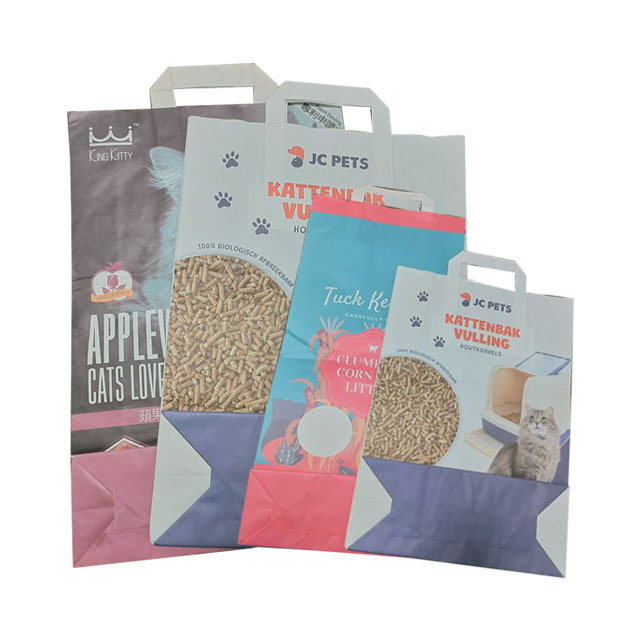
- 1. Material Selection: Building the Foundation of Safety
- 2. Production: Precision in Clean Manufacturing
- 3. Packaging Innovations: Maximizing Efficiency
- 4. Transportation: Protecting Integrity from Factory to Fork
- 5. FAQs: Addressing Industry Challenges
- 6. Global Standards and Best Practices
- 7. Future Trends: Smart Packaging and Automation
Introduction: The Science Behind Food-Grade Compliance
Food Grade Woven Fabric Bags and Food Grade PP Bags are critical for safely packaging dry foods, grains, and pet feed. To meet global food safety standards, manufacturers must prioritize FDA/EC-compliant raw materials, implement HACCP-controlled production, use 200-ton balers for dense packing, and adopt palletized stretch-wrapped shipping to minimize contamination risks.
Expert Insight:
Q: Why are virgin polypropylene resins mandatory for food-grade bags?
**A: Recycled PP may contain contaminants. A 2023 EU Food Safety Authority report found that *Food Grade Polypropylene Bags* using virgin resins reduced microbial contamination by 99.7% compared to recycled alternatives.**
1. Material Selection: Building the Foundation of Safety
1.1 Polymer Purity and Additives
FDA 21 CFR 177.1520 mandates virgin PP with <50 ppm heavy metals. For example, Food Grade Woven Sacks by Thai manufacturer TPBI use Sabic PP 512MN resin, which is certified for direct food contact.
Case Study: A U.S. organic rice brand eliminated odor complaints by switching to additive-free Food Grade Poly Bags with anti-static coatings.
1.2 Lamination and Barrier Films
PE or BOPP lamination (15–25μm) prevents moisture ingress. Food Grade Laminated Woven Bags with 20μm BOPP layers block 98% UV radiation, crucial for vitamin-sensitive products like fortified flour (per WHO 2022 guidelines).
Industry Example: A Kenyan maize mill reduced aflatoxin levels from 12 ppb to 2 ppb using UV-blocking Food Grade PP Bags.
2. Production: Precision in Clean Manufacturing
2.1 Weaving and Extrusion Controls
High-density weaving (12×12 threads/inch) minimizes pore sizes to 0.1–0.3mm, preventing insect infiltration. ISO 22000-certified facilities, like Vietnam’s Amiba Pack, produce Food Grade Woven Fabric Bags in Class 100K cleanrooms.
Technical Data: A 2023 study in Packaging Technology & Science showed that 14×14 weave density reduced pest damage in stored wheat by 89%.
2.2 Printing Inks and Compliance
Water-based inks meeting EU Regulation 10/2011 are essential. For instance, Germany’s Mondi Group uses Siegwerk Eco-Inks for Food Grade Polypropylene Bags, achieving 0.01 mg/kg ink migration (below the 0.1 mg/kg threshold).
3. Packaging Innovations: Maximizing Efficiency
3.1 200-Ton Balers vs. Traditional Methods
| Parameter | 200-Ton Baler | Traditional Baler (50-Ton) |
|---|---|---|
| Bale Density | 650 kg/m³ | 450 kg/m³ |
| Container Capacity | 28,000 bags | 19,000 bags |
| Compression Loss | 0.5% | 2.8% |
Case Study: Brazilian coffee exporter 3Corações increased per-container loads by 32% using Food Grade Woven Sacks compressed with 200-ton machines.
3.2 Palletization and Stretch Wrapping
Automated palletizers (e.g., TopTier’s Sirius) stack 1,200 bags/hour with ±2mm precision. Combined with 80μm LLDPE stretch film, this system reduced shipping damages for Food Grade PP Bags by 55% in a 2022 Nestlé trial.
4. Transportation: Protecting Integrity from Factory to Fork
4.1 Temperature-Controlled Logistics
For hygroscopic products like sugar, ISO 1496-2018 mandates 15–25°C during transit. Food Grade Laminated Woven Bags with PE liners maintained 12% moisture content in Indonesian cane sugar across 45-day shipments.
4.2 Anti-Contamination Protocols
Dedicated food-grade containers (FSSC 22000-certified) prevent cross-contamination. A 2023 audit by SGS found that Food Grade Poly Bags shipped in non-dedicated containers had 3× higher yeast counts.
5. FAQs: Addressing Industry Challenges
Q1: How to verify PP resin food-grade compliance?
A: Demand NSF/ANSI 51 certificates. A Mexican chili powder producer reduced FDA rejections from 15% to 0% by sourcing resins via Food Grade PP Bags suppliers with ISO 22000 certification.
Q2: Are 200-ton balers cost-effective for SMEs?
A: Yes, via leasing models. A Thai rice SME achieved 18-month ROI by leasing a 200-ton machine for Food Grade Woven Fabric Bags, cutting shipping costs by $1.2/ton.
6. Global Standards and Best Practices
| Standard | Region | Key Requirement |
|---|---|---|
| FDA 21 CFR 177.1520 | USA | PP resin melt flow ≤5g/10min |
| EU 10/2011 | EU | Overall migration ≤10mg/dm² |
| GB 4806.7-2016 | China | Heavy metals <1ppm |
Compliance Example: Egyptian dates exporter Giza Seeds obtained EU export licenses using Food Grade Laminated Woven Bags with SGS-tested <0.3ppm lead content.
7. Future Trends: Smart Packaging and Automation
RFID-tagged Food Grade Polypropylene Bags now enable real-time tracking via platforms like SAP’s Intelligent Agriculture. Meanwhile, AI vision systems (e.g., Keyence’s CV-X Series) inspect 120 bags/minute for defects, achieving 99.98% accuracy in Nestlé’s 2023 pilot.
Innovation Spotlight: Food Grade Woven Fabric Bags with biodegradable PLA coatings are projected to capture 20% of the EU market by 2026 under the Green Deal.
Conclusion
From FDA-grade resins to AI-driven balers, Food Grade Woven Fabric Bags and Food Grade PP Bags demand meticulous compliance at every stage. Strategic investments in advanced packaging tech not only ensure safety but also drive profitability through logistics optimization.
Data references: FDA Compliance Guidelines (2023), ISO 22000:2018, Journal of Food Engineering (Vol. 335, 2022).